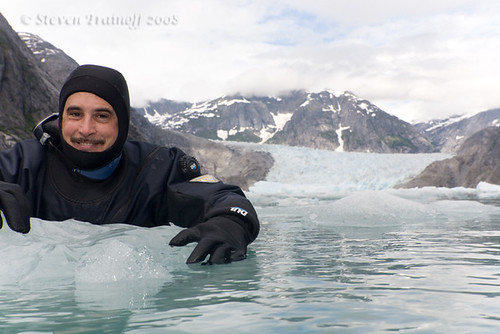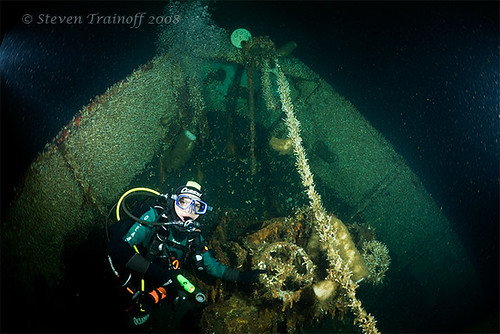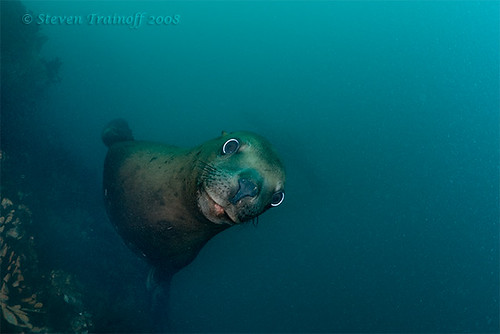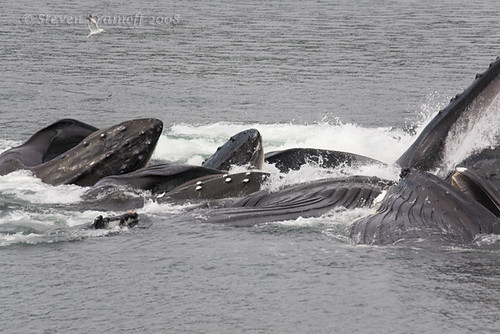spt29970
Contributor
Do you ski naked? Of course not! Then why do some people think that cold-water divers dive in nothing more than a bathing suit? Diving is as much about thermal protection as it is about tanks, regulators, and BCDs. How many of you have had a variation on the following exchange while traveling?
Tropical Diver (TD): “Oh, you are a diver too? I love to dive. Where have you done most of your diving?”
Me: “I love to dive off the coast of California. The kelp forests in the Channel Islands are some of the most spectacular habitats in the world. It is like flying through an exotic rainforest with fish and sea lions dashing through the swaying fronds”
TD: “But isn’t the water (looking a little squeamish), like freezing?”
Me: “Well, in the summer it gets up into the mid to upper 60s, but in the winter, it drops down to the low 50s. With a good wetsuit or better yet, a good drysuit, it is absolutely doable…”
TD: “Brrrr!?! (with a knowing smile) I NEVER get in the water unless it is over 80.”
You can then see TD thinking: “You must be crazy.” Well, maybe I am, but as much as I love diving in tropical destinations, there is more to the oceans than coral reefs. Don’t get me wrong. Coral reefs are beautiful, but I can’t understand someone who is proud that ¾ of the worlds oceans are off limits to him or her. Case-in-point, consider the trip that my wife and I just took to Alaska. I have to say up front, that Alaska and British Columbia had some of the most interesting and beautiful diving that I have ever done.
We took the Nautilus Explorer on a 10 day trip from Vancouver to Juneau through the inside passage. The NE is a magnificent 116’ dedicated dive boat. On our trip we had 19 passengers and 7 crew. The crew work amazingly hard and provide an unparalleled live-aboard experience.
As much as I contend that cold water diving can be excellent, I will be the first to admit that it can be challenging. The water on this trip was a uniform 45F, but my drysuit was up to the task. I was able to do 50-60 minutes dives without any problem, although even with dry-gloves, my fingers started to get cold at the end of each dive. The one big glitch with my gear occurred on the very first dive. I was down 46 minutes and the neck seal on my drysuit leaked, badly. I came up soaked to the waist. It turns out that my neck seal had leaked on my last dive at home in Santa Barbara, but I thought that it was because I had a surface swim through the kelp. No; it was just its time. It could have been a showstopper, but when I bought my DUI drysuit I opted for the ZipSeals to deal with this exact problem. I zipped a spare seal on and 5 minutes later I was good to go. I was dry as a bone for the rest of the trip.
The inside passage is a fascinating dive destination. It is an ocean passage that is protected from waves by a network of islands. For most of the trip the water was as flat as a lake, although being ocean, it is subjected to strong tidal flows. We only did two dives a day, carefully timed to slack tide.
The trip was a photographer’s dream. It is hard to list everything that we saw and did. It seemed that every day had a new revelation. British Columbia and Alaska are dominated by superlatives. It seems that everything is on a bigger scale than our normal existence.
Since we were traveling in late summer, the water was green and visibility was limited to 10-15 feet for the upper 30-40 feet. Drop down below this plankton bloom and a magical world awaited. Visibility increased to 50-100ft and the ocean was illuminated by a magical emerald glow unlike anything I have experienced before. Much of the sea life was familiar enough. There were kelp greenlings, lingcod, and rockfish. There were metridiums and gorgonians, but they all looked the victims of a nuclear accident. They were enormous! There was also plenty that was new: giant pacific octopus, wolf eels, and ratfish.

One high point of the trip was when we took the NE up the Wrangell Narrows to the LeConte Glacier. LeConte is 21 miles long and 1 mile wide. It is the southernmost tidewater glacier in the word, which means that at its terminus it spills into the ocean. Where it meets the water it is 200ft high and 800 feet deep, and the fluctuating tides put a lot of stress on the ice, guaranteeing a continuous supply of calving icebergs. It also is also famous for its “shooter” icebergs. These are bergs that break off under the water and rocket to the surface with enough force that they can leap out of the water. We saw a couple of bergs calve from the top with resounding booms, but we didn’t see any shooters. However, the trip to and from the glacier was through narrows filled with floating (and grounded) icebergs. They got so thick that the water was more like a slushy. Although Captain Mike Lever took it at dead slow, you could see and hear them grinding along the hull with a groaning sound that gave everyone mental images of the Titanic.
After observing the glacier show, the real fun began. There was a couple other small sight seeing boats in the area. One shouted to us that they were crazy Canadians. I shouted back that we were American and I asked if they were going in the water. They noticed all of the dive gear on deck and said “No. Are you crazy??? I’d rather be diving in Tahaiti!” Without missing a beat, I shouted back, “If that’s the case, you are headed in the wrong direction!!!” We then donned our drysuits and jumped over the side. We were only snorkeling since the water beneath the glacier is very turbid due to all of the ground rock and dirt that gets churned up by the calving.
Climbing on an iceberg is trickier than it looks because they are as slippery as… well… wet ice. I was surprised at how massive, even the smallest berg is. They are roughly a metric tonne per cubic meter. The small iceburg that we climbed on must have been at least 50-100 tonnes. After playing “king of the ice mountain” and “wet seal”, it was time to leave. Too bad, because it was a complete blast. I have never seen a group of adults giggle quite so much.

Another highlight of the trip was diving on the wreck of the Transpac. This was a large fishing boat that sank in a narrow channel in 1986. The inexperienced captain came upon a barge in the middle of the night. Instead of turning right-to-right to avoid a collision, he turned left and got “t-boned”. The thing that makes this wreck interesting is that although the passage is narrow, the walls are very sheer and the channel is extremely deep. In the middle the depth is over 1500ft. When the boat wrecked, it slid against one of the walls, and instead of plunging into the abyss, it came to rest with its stern on a small ledge at 250ft. The bow sticks straight up in the water column and the superstructure juts out into the channel. It is a deep dive, with the top of the bow at 115 ft. We adjusted our Nitrox mix to 27% and did the dive. The visibility at depth was excellent, at least 80ft+. I don’t normally like deep dives since they go so quickly and I get narced pretty easily, but this one was fascinating. The wreck is beautifully intact, with all of the windows unbroken in the wheelhouse.

Yet another highlight was diving off of Inian Island, which has a Steller sea lion rookery about a half a mile away. Steller sea lions are more gregarious than the California sea lions we are used to. Of course they have also been dusted with the magic Miracle-Gro that affects everything in Alaska. An adult male California sea lion may get as big as 500-600lbs, whereas a Steller will top the scales at 2000-2200lbs. As someone said, imagine a Grizzly bear with fins! As soon as we splashed, the welcoming party of juveniles and females put in an appearance. Soon they were dive-bombing us, nibbling on fins, and tugging on our drysuits. I was in photographer heaven, until a big adult male came up and ROARED at me underwater. I didn’t hear, as much as feel, an earthquake in my chest. In this game of dominance, I was bound to lose. I beat a hasty retreat to a crack in wall and waited for Mr. Big to go his way.

Even though the diving was wonderful, there were plenty of things to do topside. I am running out of space, but let me list a few of the amazing sights and experiences that we had. We saw pods of Orca, humpback whales breaching completely out of the water. We hiked up to a hot springs, and roamed around an abandoned cannery ghost town. We saw bears and eagles and even arctic puffin. We donned the drysuits and emulated the salmon by swimming (crawling) up a salmon stream. And on the last day were we treated to the spectacle of humpback bubble-net feeding. This is a mind-blowing sight. A group of 5-20 humpback whales simultaneously dive. Then they swim in a circle and blow a ring of bubbles around a school of baitfish. The bubbles scare the fish into the center of the bubble-net, and then the humpbacks blast through the center of the trap and leap out of the water with their mouths gaping. They crash into each other with a tremendous splash. Once they have found a productive fishing ground they repeat this performance over and over again until they are gorged.

We ended out trip with three days in Juneau, during which we saw the local sights, but mostly relaxed and recovered from the constant action of our vacation by hiking and dog sledding. At the end of the trip someone asked me if I would do more cold water diving. I looked at them like they were crazy. “Are you kidding? This was one of the best trips I have ever done. OF COURSE I would do it again; in a heart-beat!” I am a cold-water diver and the whole ocean is my playground. For more photos visit my web site at Flickr: - drsteve -'s Photostream
Tropical Diver (TD): “Oh, you are a diver too? I love to dive. Where have you done most of your diving?”
Me: “I love to dive off the coast of California. The kelp forests in the Channel Islands are some of the most spectacular habitats in the world. It is like flying through an exotic rainforest with fish and sea lions dashing through the swaying fronds”
TD: “But isn’t the water (looking a little squeamish), like freezing?”
Me: “Well, in the summer it gets up into the mid to upper 60s, but in the winter, it drops down to the low 50s. With a good wetsuit or better yet, a good drysuit, it is absolutely doable…”
TD: “Brrrr!?! (with a knowing smile) I NEVER get in the water unless it is over 80.”
You can then see TD thinking: “You must be crazy.” Well, maybe I am, but as much as I love diving in tropical destinations, there is more to the oceans than coral reefs. Don’t get me wrong. Coral reefs are beautiful, but I can’t understand someone who is proud that ¾ of the worlds oceans are off limits to him or her. Case-in-point, consider the trip that my wife and I just took to Alaska. I have to say up front, that Alaska and British Columbia had some of the most interesting and beautiful diving that I have ever done.
We took the Nautilus Explorer on a 10 day trip from Vancouver to Juneau through the inside passage. The NE is a magnificent 116’ dedicated dive boat. On our trip we had 19 passengers and 7 crew. The crew work amazingly hard and provide an unparalleled live-aboard experience.
As much as I contend that cold water diving can be excellent, I will be the first to admit that it can be challenging. The water on this trip was a uniform 45F, but my drysuit was up to the task. I was able to do 50-60 minutes dives without any problem, although even with dry-gloves, my fingers started to get cold at the end of each dive. The one big glitch with my gear occurred on the very first dive. I was down 46 minutes and the neck seal on my drysuit leaked, badly. I came up soaked to the waist. It turns out that my neck seal had leaked on my last dive at home in Santa Barbara, but I thought that it was because I had a surface swim through the kelp. No; it was just its time. It could have been a showstopper, but when I bought my DUI drysuit I opted for the ZipSeals to deal with this exact problem. I zipped a spare seal on and 5 minutes later I was good to go. I was dry as a bone for the rest of the trip.
The inside passage is a fascinating dive destination. It is an ocean passage that is protected from waves by a network of islands. For most of the trip the water was as flat as a lake, although being ocean, it is subjected to strong tidal flows. We only did two dives a day, carefully timed to slack tide.
The trip was a photographer’s dream. It is hard to list everything that we saw and did. It seemed that every day had a new revelation. British Columbia and Alaska are dominated by superlatives. It seems that everything is on a bigger scale than our normal existence.
Since we were traveling in late summer, the water was green and visibility was limited to 10-15 feet for the upper 30-40 feet. Drop down below this plankton bloom and a magical world awaited. Visibility increased to 50-100ft and the ocean was illuminated by a magical emerald glow unlike anything I have experienced before. Much of the sea life was familiar enough. There were kelp greenlings, lingcod, and rockfish. There were metridiums and gorgonians, but they all looked the victims of a nuclear accident. They were enormous! There was also plenty that was new: giant pacific octopus, wolf eels, and ratfish.

One high point of the trip was when we took the NE up the Wrangell Narrows to the LeConte Glacier. LeConte is 21 miles long and 1 mile wide. It is the southernmost tidewater glacier in the word, which means that at its terminus it spills into the ocean. Where it meets the water it is 200ft high and 800 feet deep, and the fluctuating tides put a lot of stress on the ice, guaranteeing a continuous supply of calving icebergs. It also is also famous for its “shooter” icebergs. These are bergs that break off under the water and rocket to the surface with enough force that they can leap out of the water. We saw a couple of bergs calve from the top with resounding booms, but we didn’t see any shooters. However, the trip to and from the glacier was through narrows filled with floating (and grounded) icebergs. They got so thick that the water was more like a slushy. Although Captain Mike Lever took it at dead slow, you could see and hear them grinding along the hull with a groaning sound that gave everyone mental images of the Titanic.
After observing the glacier show, the real fun began. There was a couple other small sight seeing boats in the area. One shouted to us that they were crazy Canadians. I shouted back that we were American and I asked if they were going in the water. They noticed all of the dive gear on deck and said “No. Are you crazy??? I’d rather be diving in Tahaiti!” Without missing a beat, I shouted back, “If that’s the case, you are headed in the wrong direction!!!” We then donned our drysuits and jumped over the side. We were only snorkeling since the water beneath the glacier is very turbid due to all of the ground rock and dirt that gets churned up by the calving.
Climbing on an iceberg is trickier than it looks because they are as slippery as… well… wet ice. I was surprised at how massive, even the smallest berg is. They are roughly a metric tonne per cubic meter. The small iceburg that we climbed on must have been at least 50-100 tonnes. After playing “king of the ice mountain” and “wet seal”, it was time to leave. Too bad, because it was a complete blast. I have never seen a group of adults giggle quite so much.

Another highlight of the trip was diving on the wreck of the Transpac. This was a large fishing boat that sank in a narrow channel in 1986. The inexperienced captain came upon a barge in the middle of the night. Instead of turning right-to-right to avoid a collision, he turned left and got “t-boned”. The thing that makes this wreck interesting is that although the passage is narrow, the walls are very sheer and the channel is extremely deep. In the middle the depth is over 1500ft. When the boat wrecked, it slid against one of the walls, and instead of plunging into the abyss, it came to rest with its stern on a small ledge at 250ft. The bow sticks straight up in the water column and the superstructure juts out into the channel. It is a deep dive, with the top of the bow at 115 ft. We adjusted our Nitrox mix to 27% and did the dive. The visibility at depth was excellent, at least 80ft+. I don’t normally like deep dives since they go so quickly and I get narced pretty easily, but this one was fascinating. The wreck is beautifully intact, with all of the windows unbroken in the wheelhouse.

Yet another highlight was diving off of Inian Island, which has a Steller sea lion rookery about a half a mile away. Steller sea lions are more gregarious than the California sea lions we are used to. Of course they have also been dusted with the magic Miracle-Gro that affects everything in Alaska. An adult male California sea lion may get as big as 500-600lbs, whereas a Steller will top the scales at 2000-2200lbs. As someone said, imagine a Grizzly bear with fins! As soon as we splashed, the welcoming party of juveniles and females put in an appearance. Soon they were dive-bombing us, nibbling on fins, and tugging on our drysuits. I was in photographer heaven, until a big adult male came up and ROARED at me underwater. I didn’t hear, as much as feel, an earthquake in my chest. In this game of dominance, I was bound to lose. I beat a hasty retreat to a crack in wall and waited for Mr. Big to go his way.

Even though the diving was wonderful, there were plenty of things to do topside. I am running out of space, but let me list a few of the amazing sights and experiences that we had. We saw pods of Orca, humpback whales breaching completely out of the water. We hiked up to a hot springs, and roamed around an abandoned cannery ghost town. We saw bears and eagles and even arctic puffin. We donned the drysuits and emulated the salmon by swimming (crawling) up a salmon stream. And on the last day were we treated to the spectacle of humpback bubble-net feeding. This is a mind-blowing sight. A group of 5-20 humpback whales simultaneously dive. Then they swim in a circle and blow a ring of bubbles around a school of baitfish. The bubbles scare the fish into the center of the bubble-net, and then the humpbacks blast through the center of the trap and leap out of the water with their mouths gaping. They crash into each other with a tremendous splash. Once they have found a productive fishing ground they repeat this performance over and over again until they are gorged.

We ended out trip with three days in Juneau, during which we saw the local sights, but mostly relaxed and recovered from the constant action of our vacation by hiking and dog sledding. At the end of the trip someone asked me if I would do more cold water diving. I looked at them like they were crazy. “Are you kidding? This was one of the best trips I have ever done. OF COURSE I would do it again; in a heart-beat!” I am a cold-water diver and the whole ocean is my playground. For more photos visit my web site at Flickr: - drsteve -'s Photostream




